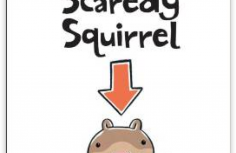To allow the brain to focus on the information in the illustrations, this reading will look only at the illustrations and the information they provide to the reader. There are no right or wrong answers in this reading. If the pages are not numbered, page 1 is the first page of text.
Your child will be asked to infer what Scaredy might be thinking and feeling in the illustrations. The facial expressions are important information in forming the inferences. If your child answers a question by saying, “I don’t know.” Respond, “We may find the answer when we read the story.”
Ms. Watt uses charts and lists several times during the story. The pages with charts and lists will be covered in this reading. The charts and lists are not considered text.
Page 1:
Meet Scaredy.
~ Point out that Scaredy is in a tree full of nuts. This is the kind of tree most squirrels love. Discuss the prior knowledge your child already has about squirrels.
~Talk about the trees in your neighborhood. Are there any trees that squirrels would love to have as a home?
Pages 2 – 3:
~unknown: strange, not familiar. The area shown in the illustration is “unknown” to Scaredy. What does that mean? (Scaredy has never been in the area shown.)
~Why might Scaredy have never gone to this area?
Pages 4 – 5:
~chart: a special way to organize information. This is the first chart. Use the word chart when explaining how the author is showing you Scaredy’s fears with one fear in each box. Talk about charts as being an easy way to organize information.
~Talk about what Scaredy is afraid of. Are these things that you would expect a squirrel to fear?
~Are you and Scaredy afraid of the same things?
Pages 6 – 7:
~Does Scaredy look afraid? Explain your answer. (winking and thumb up)
~Can you tell where Scaredy is? (At the bottom of the illustration, it looks like he is in his tree.)
Pages 8 – 9:
~list: similar to a chart, an easy way to organize information
Discuss that these two pages are lists. How are lists like charts? (used to organize information in an easy-to-understand way) Can you think of any lists that your child and you use?
~advantages: opportunities that leads to success
~disadvantages: things that put someone in a bad situation
~Can you think of additional advantages or disadvantages for never leaving the nut tree?
Pages 10 – 11:
~This is another list. What information is on this list?
~How does Scaredy seem to be feeling each day?
Pages 12 – 13:
~daily routine: doing the same things each day and doing these things in basically the same order. Discuss what might be in your daily routine.
~What do you think of Scaredy’s daily routine?
Pages 14 – 15:
~Locate the light bulb over Scaredy’s head. Discuss the meaning of this symbol. (It usually means that the character has thought of a great idea.)
~Look at page 15. What do you think Scaredy’s great idea might be?
Pages 16 – 17:
~This is another chart. Discuss the information shown in this chart.
~Discuss why each item is in his emergency kit. (You might need to refer to the chart showing Scaredy’s fears.)
*calamine lotion = helps to heal poison ivy
*sardines = feed the sharks
Pages 18 – 19:
~exit: a way out.
~Page 19 is a chart. Discuss what the chart is showing. Why might Scaredy need four different exit plans?
Pages 20 – 21:
~What might Scaredy be looking for?
~On page 21, what does he see?
Pages 22 – 23:
~Why is Scaredy yelling? Predict what he will do next.
Pages 24 – 25:
~Describe what you think is happening.
~How does the killer bee seem to be feeling?
Pages 26 – 27:
~The expressions on Scaredy’s face change. Why might his feelings be changing?
~What could the score card that Scaredy is holding mean? (Similar to a score given by a judge at an athletic competition. Scaredy thinks he his gliding earned a good score.)
Pages 28 – 29:
~Discuss the information on the chart. Why might Scaredy be playing dead? (Remember page 19 – another chart that mentioned playing dead.)
~What do you think Scaredy is doing on page 29? Infer why he might be doing that.
Pages 30 – END:
~new and improved: (better) How is Scaredy’s new daily routine better than his previous daily routine?
~Page 32, how is Scaredy feeling at the end of the story?
~Why might it be difficult for Scaredy to get his emergency kit? Think of a plan to help him.
Read more...

